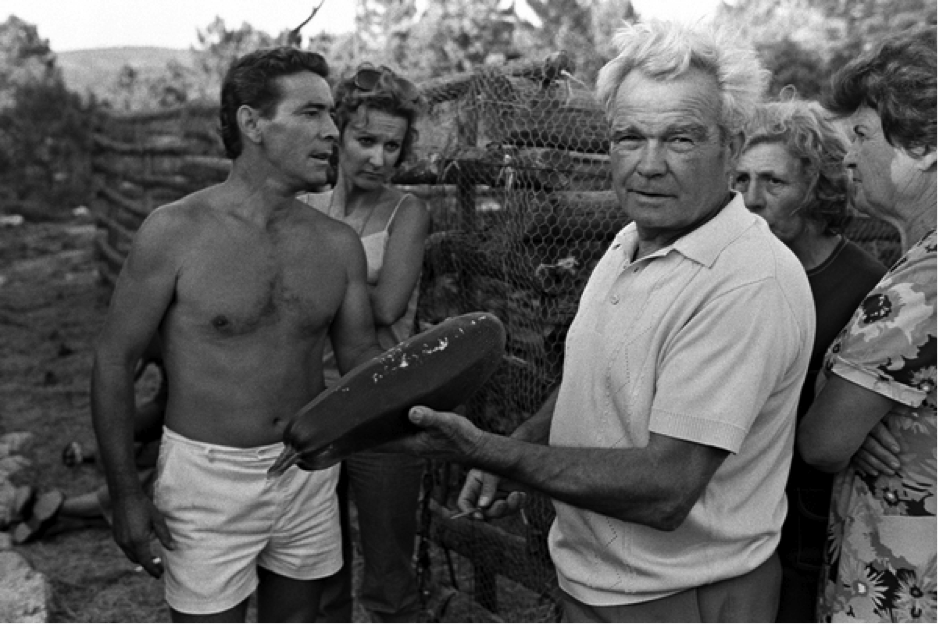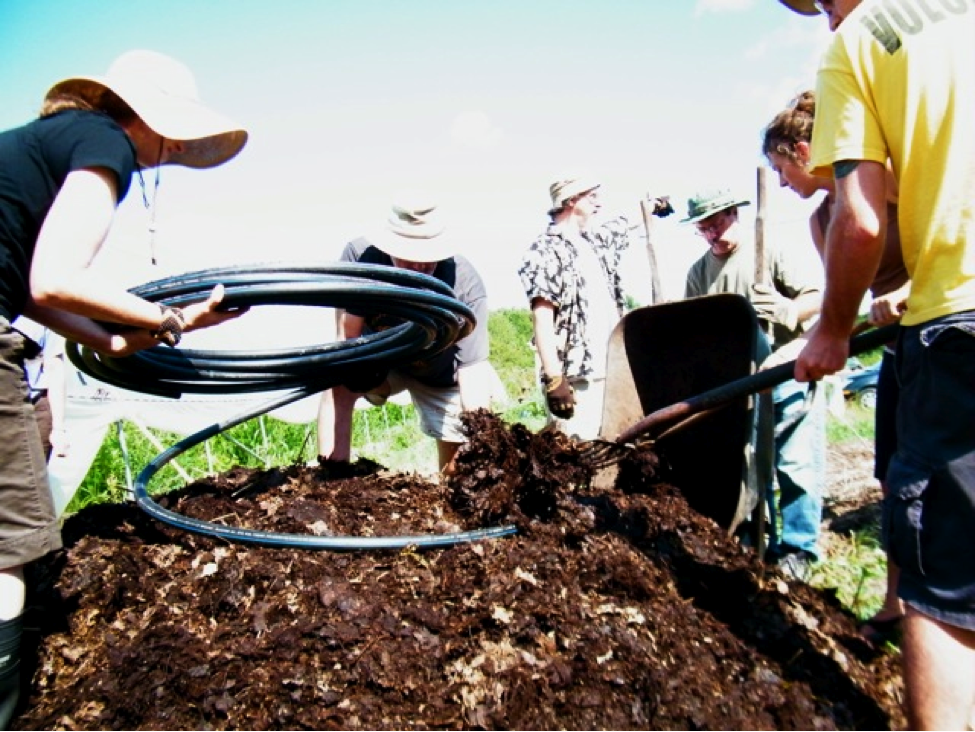For those of us who have successfully composted in the past, we know that a properly made compost pile produces a substantial amount of heat. In fact, when the pile stops creating heat it is usually done “cooking” and ready for the garden.
We focus a lot on leveraging technology to become more resilient. So what can we learn from a Frenchman who died over three decades ago?
A lot!
What is a Compost Water Heater?
Simply put, it’s a giant pile of compost with tubing that is coiled throughout the compost pile and then filled with water. The water within the tubing heats up substantially (and relatively quickly).
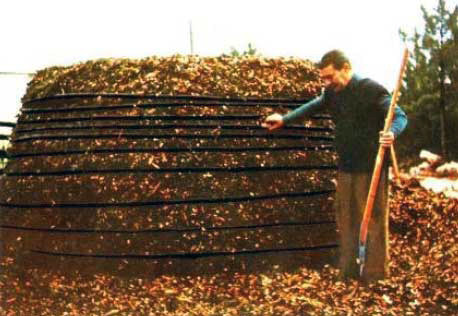
Jean Pain in the process of building a compost water heater
To give you a glimpse of what a real-life compost water heater is capable of, here’s Ben Falk at Whole Systems Design in Vermont showing off their first generation compost water heater:
They used a mix of wood chips and horse manure to build this compost water heater, and got hot water with temperatures of 140 – 145 degrees Fahrenheit (~ 60 degrees Celcius). Not bad.
Who is Jean Pain?
Jean Pain was a French innovator who lived in southern France from 1930 until his passing in 1981. He was able to create a compost-based energy production system that was capable of producing 100% of his energy needs.
Using compost alone, Jean was able to heat water to 140°F. He used this water for washing, cooking and heating his home. We aren’t talking about a small amount of water either. His system was able to heat water at a rate of 4 L per minute; or almost 1 gallon per minute.
Many of our modern hot water heaters can’t even boast figures that impressive.
In addition to heating water using compost, Jean also distilled methane to run a generator, a stove, and fuel his vehicle.
The work he did is still viable today. Sometimes known as Jean Pain Composting or the Jean Pain Method, we can learn a lot from the work of this Frenchman about resiliency.
Interestingly enough, just about all of Jean’s work is in French. There are English translations available around the Internet, however, so with a little bit of research we can take advantage of Mr. Pain’s successes as one of the early innovators of modern resiliency.
If you are interested in learning more about the work of Jean Pain, check out the book entitled “Another Kind of Garden.” It is translated from the original French so it is a little hard to read, but the information is extremely interesting and we could all learn a thing or two from his work.
How Does it Work?
It may seem unbelievable that a simple compost pile filled with anaerobic bacteria could heat water to temperatures hot enough to scald skin. It is, however, entirely possible and easily replicated at home.
You only need to search YouTube for a few minutes to find thousands of videos detailing variations of Jean Pain’s design being used in towns and cities around the world.
As mentioned, the basic idea behind a compost water heater is that tubing is coiled throughout the compost pile and then filled with water, which in turn is heated by the compost pile.
As the below image illustrates, cold water goes into the coiled tube and hot water comes out. Not only that but it’s also possible to extract methane gas from the compost pile, which can then be used for cooking or heating.
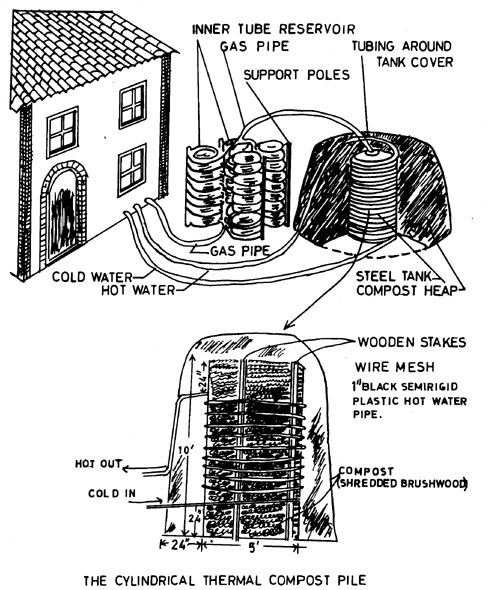
Looking back at the work of Jean Pain, his compost piles built with wood chips were massive. In some cases, he was employing 60 tons of compost in a single pile to provide his energy needs. More recently, however, experiments have used piles that are as small as 6’ x 6’ to create a similar effect. Some of these modern piles are producing temperatures of 150°F or more.
The trick to improving the original design is the use of more polyethylene tubing. In the typical 6’ x 6’ compost pile mentioned above, you might expect to use at least 300 feet of 1 inch diameter polyethylene tubing. This tubing is carefully coiled and layered in between the layers of compost to repeatedly heat the water as it moves through the various layers of the coil system.
As a general rule, the pile will start with a compressed layer of compost followed by a layer of coiled tubing followed by a layer of compressed compost until you reach the desired height.
Since a compost water heater does not have a hot water tank, the tubing becomes the “tank” in this example. This means that the more tubing you use, the more hot water you will have available at a given time. Think long, relaxing shower versus being the last one in the house to get a shower before work.
Although the original designs of Jean Pain did not include a hot water tank, there has also been some interesting research done in the last few years where this technique is combined with the use of a conventional hot water tank as a way to preheat water entering the tank. This is an excellent way to save on your energy bill without relying completely on the benefits of a compost water heater.
Once the decomposition process is functioning properly within the compost pile, you can expect several weeks of reliable water temperatures. In the early 80s, Mother Earth News tested a design very similar to Jean Pain’s system and was able to achieve consistent water temperatures above 130°F for several months before the heating action began to dwindle.
The length of time your compost water heater provides a reliable energy source depends on its construction. Not only do you have to consider how large your pile will be, but the ingredients you put in it and the amount of tubing you use are also considerations when designing your own compost water heating system.
Additional Thoughts
Based on the experimentation of others, there are a couple of things you want to keep in mind if you decide to create your own compost water heater. First, try to locate the compost pile near the intended usage location. Obviously, heat is lost as the water travels across large distances.
Some people have created separate outdoor showers that are located just a few feet from the compost water heater.
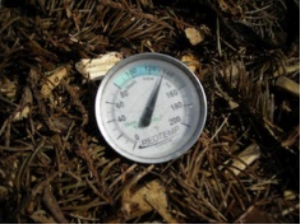
As previously mentioned, you could also consider using a compost water heater as a way to preheat water entering your hot water tank. This is often easier than implementing a standalone compost heater and it will save significant amounts of energy typically used to heat groundwater in your hot water tank.
Other people have also used compost water heaters in conjunction with various solar water heating techniques. Although a compost water heater is a very effective solution by itself, the power of the sun makes it an even more reliable option.
Thinking of Building Your Own?
Creating a compost-based water heater is excellent weekend project. The only things you really need are compostable material, an area to devote to your compost pile, and lots of polyethylene tubing.
There are tutorials all over the Internet detailing various methods – some work very well while others fall short of the performance achieved by Mr. Pain himself.
One of the most important things to remember when creating your own compost water heater is to compress the compost pile very well. Since anaerobic bacteria are responsible for heating the pile, the more compressed your compost is, the better your water heater will work.
Another thing that some people have done successfully is create two small piles with tubing coiled in each of them. In areas where space is limited, this may be a good alternative that will still heat water practically as well as a single large pile. Truly, the key is to use lots of tubing and coil it throughout the compost pile – as long as you do that, you should have no issues heating up your water to 130°F or better.
With the cold winter months fast approaching in many parts of the country, the idea of hot water that does not require any external energy source is a welcome solution and an idea we should all think about incorporating into our current resiliency plans in the near future.

